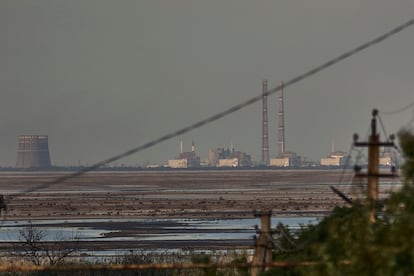Land mines are in place around a Russian-occupied nuclear plant in Ukraine, UN watchdog warns
The watchdog has repeatedly expressed concern about the war leading to a radiation leak at the facility, which is one of the world’s 10 biggest nuclear power plants

The U.N. atomic watchdog says its monitors at the Russian-occupied Zaporizhzhia Nuclear Power Plant reported seeing anti-personnel mines around the site as Ukraine’s military pursues a counteroffensive against the Kremlin’s entrenched forces after 17 months of war.
The International Atomic Energy Agency said its team observed the mines Sunday in a restricted area that is off-limits to the plant’s Ukrainian staff. The agency did not directly attribute the placement of the mines to the Russians but said its experts were told “it is a military decision, and in an area controlled by military.”
“Having such explosives on the site is inconsistent with the IAEA safety standards and nuclear security guidance and creates additional psychological pressure on plant staff,” Rafael Mariano Grossi, the agency’s director general, said in a statement late Monday.
However, any detonation of the mines, which were facing away from the plant and located between its internal and external perimeter barriers, “should not affect the site’s nuclear safety and security systems,” the statement said.
The IAEA has repeatedly expressed concern that the war could cause a potential radiation leak from the facility, which is one of world’s 10 biggest nuclear power stations. The plant’s six reactors have been shut down for months, but it still needs power and qualified staff to operate crucial cooling systems and other safety features.
Ukraine’s military intelligence said last month without providing evidence that Russia is planning a “large-scale provocation” at the nuclear power plant in the southeast of the country and had placed suspected explosives on the roof. Russia, in turn, has alleged without offering evidence that Ukraine was planning a false flag attack involving radioactive materials.
The IAEA statement said that the Russian occupiers still haven’t granted it access to the roofs of the reactors and their turbine halls.
Meanwhile, Ukrainian authorities said Tuesday that air defenses intercepted Iranian-made Shahed drones that Russia fired at Kyiv overnight, in what was the sixth drone attack on the capital this month. No casualties or damage were reported, according to Serhii Popko, head of the Kyiv regional military administration head.
The Russian Defense Ministry said a Russian patrol ship destroyed two Ukrainian sea drones that attacked it in the Black Sea early Tuesday. It said the crew of the Sergey Kotov patrol ship of the Russian Black Sea Fleet wasn’t hurt in the attack 370 kilometers (200 nautical miles) southwest of the Crimean port of Sevastopol.
Ukrainian officials, in turn, said that Russians used cluster munitions in an attack on Kostiantynivka, in the eastern Donetsk region, late Monday.
Rockets hit a recreational pond, killing a 10-year-old boy and wounding four other children ranging in age from 5 to 12, according to Pavlo Kyrylenko, head of the Donetsk regional military administration.
Russia and Ukraine have both used cluster munitions throughout the war, and the U.S. has recently provided them to Ukraine.
Western analysts said Tuesday that Russia’s recent attacks on Odesa and other parts of southern Ukraine have employed missiles that were originally developed to destroy aircraft carriers.
Each missile weighs 5.5 metric tons, the U.K. Ministry of Defense said in an assessment.
In only a week, Russia has fired dozens of missiles and drones at the Odesa region, on Monday hitting a cathedral. The strikes have come since Moscow broke off from a landmark grain deal a week ago. Odesa is a key Ukrainian hub for exporting grain.
The attacks have damaged several grain silos at Chornomorsk Port, south of Odesa, and Russian drones have hit docks on the Danube River, approximately 200 meters (650 feet) from the Romanian border, according to the assessment.
Sign up for our weekly newsletter to get more English-language news coverage from EL PAÍS USA Edition
Tu suscripción se está usando en otro dispositivo
¿Quieres añadir otro usuario a tu suscripción?
Si continúas leyendo en este dispositivo, no se podrá leer en el otro.
FlechaTu suscripción se está usando en otro dispositivo y solo puedes acceder a EL PAÍS desde un dispositivo a la vez.
Si quieres compartir tu cuenta, cambia tu suscripción a la modalidad Premium, así podrás añadir otro usuario. Cada uno accederá con su propia cuenta de email, lo que os permitirá personalizar vuestra experiencia en EL PAÍS.
¿Tienes una suscripción de empresa? Accede aquí para contratar más cuentas.
En el caso de no saber quién está usando tu cuenta, te recomendamos cambiar tu contraseña aquí.
Si decides continuar compartiendo tu cuenta, este mensaje se mostrará en tu dispositivo y en el de la otra persona que está usando tu cuenta de forma indefinida, afectando a tu experiencia de lectura. Puedes consultar aquí los términos y condiciones de la suscripción digital.
More information
Últimas noticias
Most viewed
- Sinaloa Cartel war is taking its toll on Los Chapitos
- Oona Chaplin: ‘I told James Cameron that I was living in a treehouse and starting a permaculture project with a friend’
- Reinhard Genzel, Nobel laureate in physics: ‘One-minute videos will never give you the truth’
- Why the price of coffee has skyrocketed: from Brazilian plantations to specialty coffee houses
- Silver prices are going crazy: This is what’s fueling the rally










































